The Do-or-Die Moments That Determined the Fate of the Internet
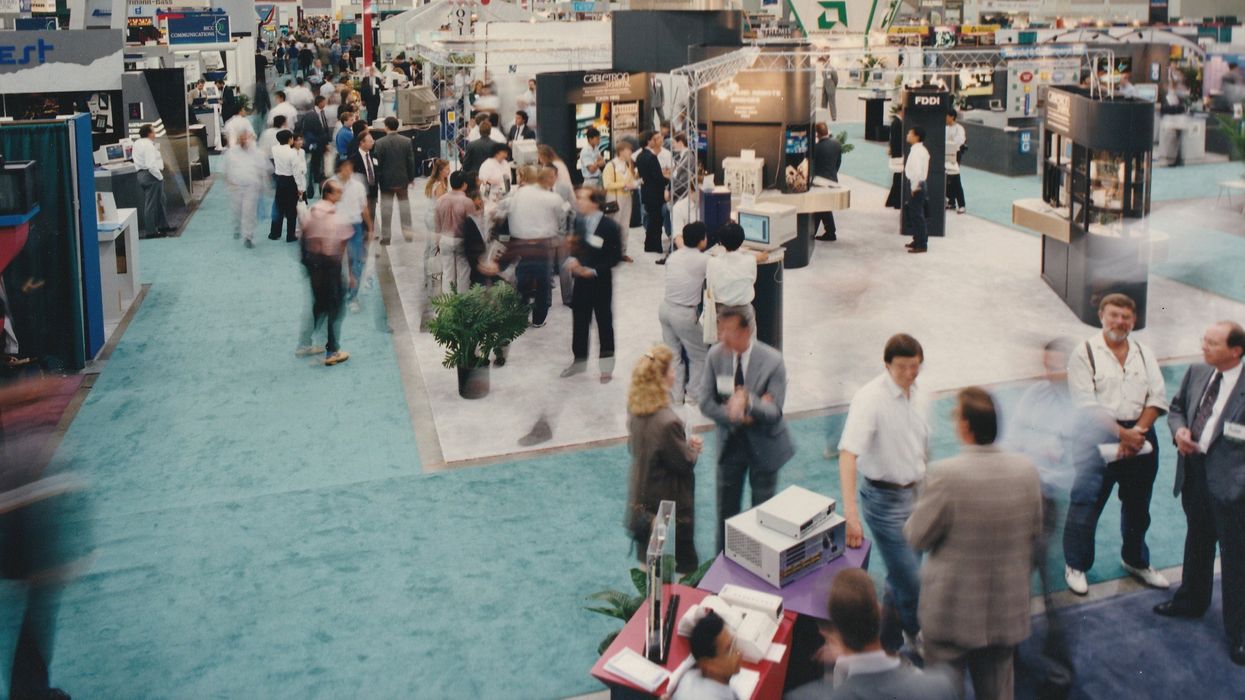
New technologies often are introduced through spectacle: Think of the historic demonstrations carried out by Faraday, Edison, Morse, and Bell, or, more recently, by Steve Jobs onstage in his black turtleneck at Macworld 2007, holding the first iPhone. Indeed, hyped-up product announcements at industry events like the Consumer Electronics Show (now CES) and the Game Developers Conference have become regular features of the digital world.
There's also a parallel tradition-less flashy but no less important-of industry events that focus attention on digital infrastructure. Several of these events, such as the first public demo of the ARPANET in 1972, or the mid-1980s conferences now known as Interop, alerted experts to new technologies, and, in some cases, altered the balance between competing approaches.
Although many of these gatherings have escaped the attention of historians, our view is that these events should be recognized more fully as moments where experts could glimpse possible futures and judge for themselves what was most likely to happen. Here we describe a few of these do-or-die moments. You may not have heard of any of these events-but if you were there, you will never forget them.
Packet Switching Comes of AgeThe ARPANET was one of the first networks to apply packet switching, an approach to communications that breaks messages into discrete chunks, or packets, of data. It was a major departure from circuit-switched networks, such as telephone networks, for which communication partners were linked through a dedicated circuit.
The first node of the ARPANET was installed at the University of California, Los Angeles, in 1969. But the ARPANET didn't take off immediately. And by mid-1971, program director Lawrence Roberts of the Advanced Research Projects Agency (ARPA) was becoming impatient with the slow pace at which ARPA-funded researchers were getting connected. One of these researchers, Bob Kahn, suggested that Roberts organize a public demonstration of the ARPANET, both to educate other researchers about the network's capabilities and to encourage new partners to support the initiative. Once Kahn found a venue for the demo-at the International Conference on Computer Communications (ICCC), to be held in Washington, D.C., in late October of 1972-he worked feverishly to get it organized.
Kahn recruited about 50 people to act as facilitators, including the ARPA-funded researchers Vint Cerf, Robert Metcalfe, and Jon Postel, all of whom were destined for networking fame. Kahn's plan called for a TIP-short for Terminal Interface Processor-to be installed at the Hilton Hotel, the site of the ICCC. From there, attendees could log on to one of the ARPANET hosts and run an application remotely.
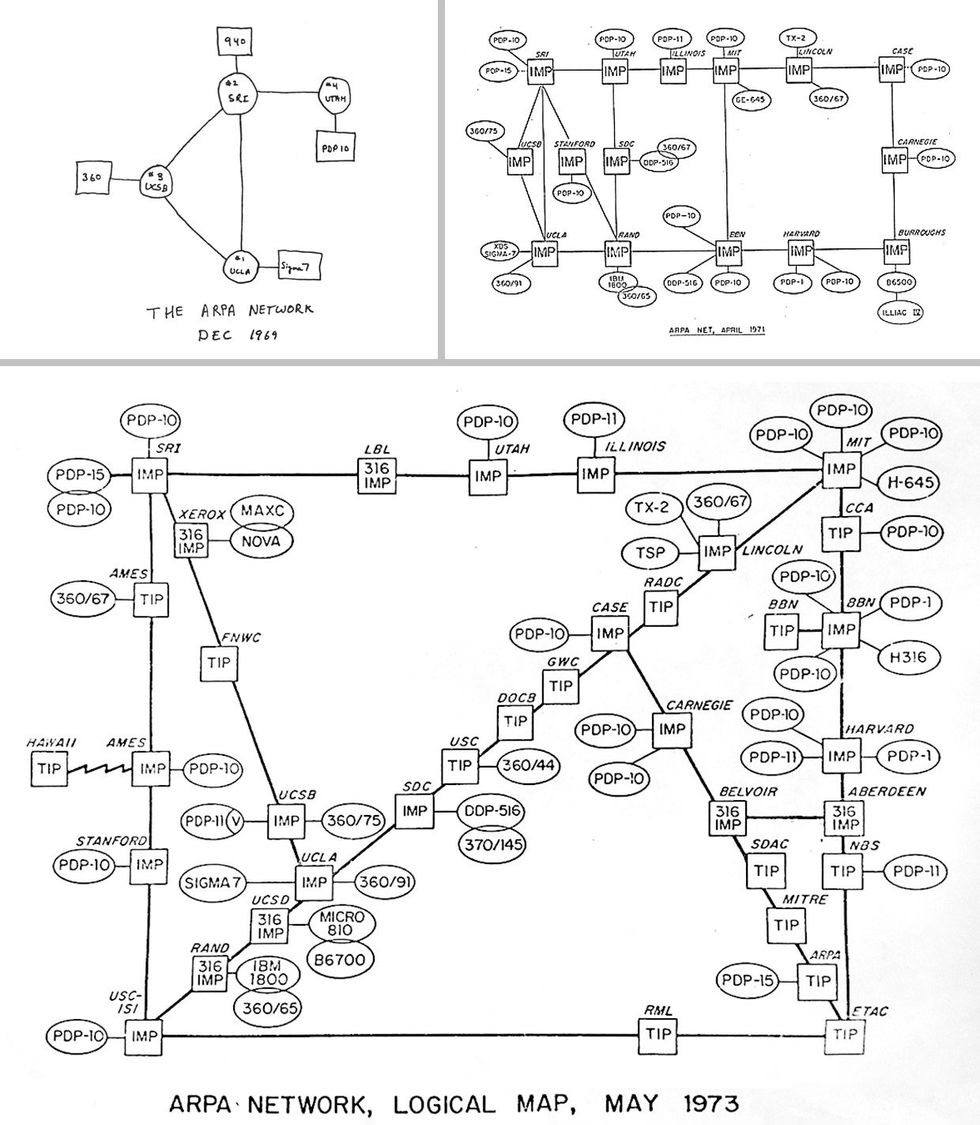 As these hand drawings from the time show, in December 1969 the ARPANET had just four nodes [top left]. That number grew to 15 by April 1971 [top right]. In an effort to speed the expansion further, network advocates organized a demonstration at the International Conference on Computer Communications in Washington, D.C., in October 1972. That meeting helped to grow the ARPANET, which by May of 1973 included some three dozen nodes [bottom].Computer History Museum
As these hand drawings from the time show, in December 1969 the ARPANET had just four nodes [top left]. That number grew to 15 by April 1971 [top right]. In an effort to speed the expansion further, network advocates organized a demonstration at the International Conference on Computer Communications in Washington, D.C., in October 1972. That meeting helped to grow the ARPANET, which by May of 1973 included some three dozen nodes [bottom].Computer History Museum
For this to work smoothly, Kahn arranged for various applications (called scenarios") to be created and tested. He also had to convince manufacturers to loan, install, and configure terminals. And he had to work with the hotel to prepare the room for the demo and arrange with AT&T to run leased lines to the Hilton's ballroom.
The ICCC would prove to be for packet switching what the 1876 Centennial Exposition in Philadelphia was for the telephone: the public unveiling of what would eventually lead to a technological discontinuity.
For the hundreds of computer-communications professionals, government employees, and academic researchers attending the ICCC, the demo permanently changed their perceptions of a computer as a single machine locked in an air-conditioned room. The TIP was on a raised floor in the middle of the ballroom, with dozens of connected computer terminals circled around it and dozens of ARPA scientists milling about, eager to show off their pride and joy.
To sit at a terminal and with a few keystrokes be connected through the TIP, to the ARPANET, and then to applications running on computers at dozens of universities and research facilities must have felt like a visit to an alien world. And for the ARPA scientists involved, the bonds formed from staging the demonstration left them heady and optimistic about the future they were creating.
Think Globally. Act LocallyResearchers in government, academia, and industry struggled over the next several years to realize the potential of what they had seen. How could they scale up and simplify the capabilities that Kahn and company spent a year bringing to the Hilton ballroom? One major problem was the cost and fragility of stringing a dedicated cable from every computer to every terminal. Several parties converged on a similar solution: a local area network, where one local" cable could traverse an entire facility with all terminals and computers connected to it.
Users in large organizations-including the U.S. Air Force, which had decades of experience and investments in computer communications-had the most to gain from solutions to these problems. To promote cooperation, Robert Rosenthal at the U.S. National Bureau of Standards and Norman Meisner at Mitre, a federally funded R&D organization, arranged a series of workshops in early 1979 to explore Local Area Network Protocols." Their goal was to provide a mechanism for sharing and obtaining results from the latest research-especially knowledge that was not available in the published literature. When Rosenthal and Meisner contacted potential participants, it became clear that while virtually everyone working on local area networking sensed its importance, they all expressed confusion over what to do about it.
When it came to sorting out the solution, a meeting Rosenthal and Meisner organized in May 1979 proved to have enduring significance. The Local Area Communications Network Symposium, held at the Copley Plaza Hotel in Boston, featured five formal sessions, panel discussions, and twelve workshops. Rosenthal was astonished when about 400 people showed up. For most, it was a formative event, comparable in importance to the ARPANET demonstration in 1972. There was electricity in the air," Rosenthal recalled in a 1988 interview with one of us (Pelkey). You had leaders [like] Bob Metcalfe saying: The world's going to be a better place.' "
Bruce Hunt of Zilog remembers being amazed at how many people were really interested in local area networks," and feeling satisfied that the instinct of the researchers involved-that they were onto something really important-was validated. And it wasn't just hype by academics: Within a couple of months, three new companies were formed-Sytek, 3Com, and Ungermann-Bass. Emboldened by the clear demand for commercial networking equipment, these startups raised millions from investors and immediately began selling products for local area networking.
More and more professionals came to realize that networking technology would generate important benefits. But the engineers involved had not settled many technical details about how these networks would work. And a growing number of alternatives soon would be considered for standardization by the IEEE, including a now well-known technology called Ethernet, which will celebrate the 50th anniversary of its standardization in May of this year.
Birth of OSIIn the meantime, work was underway on a broader approach to the challenge of creating standards for computer communication-one that could serve to link up different computer networks, a concept that began at this time to be called internetworking." In 1978, a few dozen experts from around the world held the first meeting for an ambitious project to create a comprehensive suite of standards and protocols for disparate networking technologies. This effort, known as Open Systems Interconnection (OSI), was hosted first by the International Organization for Standardization (ISO) and later, jointly, by ISO and the International Telecommunication Union. OSI's founding premise was that a layered architecture would provide a way to pull together the standards, applications, and services that diverse groups around the world were developing.
The lower layers of OSI concerned the formatting, encoding, and transmission of data over networks. The upper layers included advanced capabilities and applications, such as electronic mail and directory services.
Several initiatives examined proposals for standards and applications within OSI's seven-layer framework. One arose at General Motors, which had a strategic goal of using computer-based automation to combat growing competition from abroad. In 1981, GM held exploratory conversations with Digital Equipment Corp., Hewlett-Packard, and IBM. These discussions culminated in the release of GM's Manufacturing Automation Protocol (MAP) version 1.0 in 1982.
Boeing, with similar goals, announced that it would work with the National Bureau of Standards to lead the creation of an OSI protocol stack for technical and office environments, later to be named Technical and Office Protocols (TOP).
Once again, potential users and customers sought out live demonstrations so that they could judge for themselves what was hype and what was reality. One highly anticipated demo took place at Autofact '85, a conference whose name reflects the era's deep preoccupation with factory automation.
Autofact '85 drew about 30,000 people to Detroit, with some 200 vendors exhibiting MAP-compatible and other kinds of automation products. In addition to data-processing equipment such as computers and terminals, a variety of factory-automation systems, including robots, vision systems, and engineering workstations, were on display. With them, attendees explored a custom-designed version of the Towers of Hanoi game, and an application for interactive file transfer, access, and management.
Although Autofact '85 was well attended and generally hailed in the trade press as a success, some were put off by its focus on things to come. As one press account put it, On the show floor, there are plenty of demonstrations but few available products." The lingering questions around actual commercial applications gave promoters reason to continue organizing public demonstrations, such as the Enterprise Networking Event (ENE) in Baltimore, in June 1988.
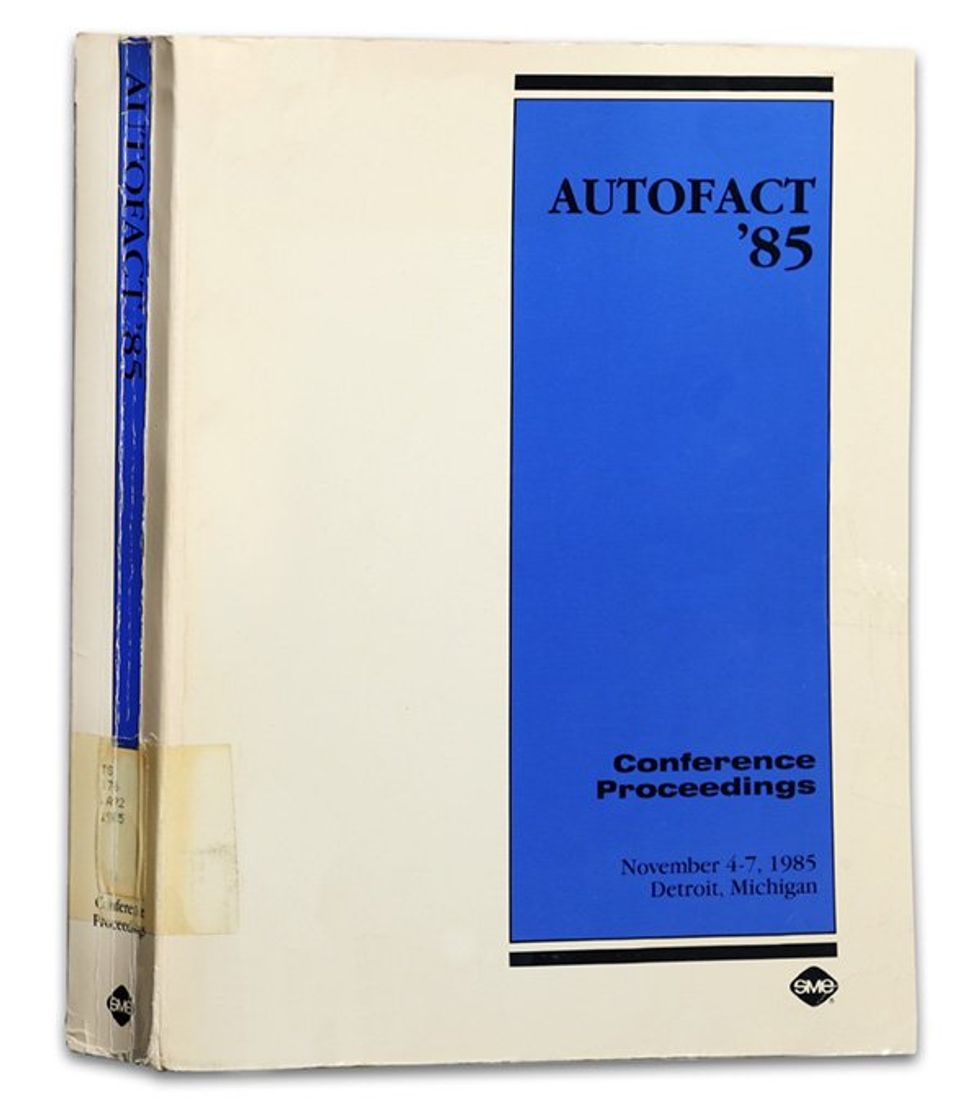 Autofact '85, a conference whose name reflects people's keen interest in factory automation during that time, brought about 30,000 people and 200 vendors to Detroit in November of 1985. SUNY Polytechnic Institute
Autofact '85, a conference whose name reflects people's keen interest in factory automation during that time, brought about 30,000 people and 200 vendors to Detroit in November of 1985. SUNY Polytechnic Institute
The hope for ENE was to provide demos as well as showcase products that were actually available for purchase. All the U.S. computing giants-including IBM, HP, AT&T, Xerox, Data General, Wang Laboratories, and Honeywell-would be there, as well as leading European manufacturers and some smaller and younger companies with OSI-compatible products, such as Apple, Micom, Retix, Sun Microsystems, 3Com, and Touch Communications. Keynote speakers from the upper levels of the U.S. Department of Defense, Arthur Andersen, and the Commission of European Communities reinforced the message that all major stakeholders were behind the global adoption of OSI.
ENE confirmed both the hopes of OSI's supporters and the fears of its critics. Vendors were able to demonstrate OSI standards for network management and electronic mail, but instead of products for sale, the 10,000 or so attendees saw mostly demonstrations of prototypes-a marginal improvement on Autofact '85.
The Internet ComethThere was a painful reality to the computer networks of the mid-1980s: On the one hand, they held a vast potential to improve business practices and enhance productivity; on the other, actual products that could integrate the diversity of installed equipment and networks-and thus provide a robust means of internetworking-were very limited. The slow progress of MAP and TOP products left an opening for alternative approaches.
And the most promising of those approaches was to rely on the core protocols then in use for the ARPANET: Transmission Control Protocol and Internet Protocol (known to insiders as TCP/IP). A broad market for suitable equipment hadn't yet developed, but the community of experts that had grown around the ARPANET was increasingly active in promoting the commercial adoption of such products.
One of the chief promoters was Dan Lynch, a consultant who was instrumental in managing the ARPANET's transition to TCP in 1983. Lynch led the planning of a workshop in Monterey, Calif., in August 1986, where equipment vendors could learn about TCP/IP. Lynch wanted to get the apostles of TCP to come out of their ivory towers" and provide some guidance for vendors implementing their protocols. And they did, as Lynch recalled in a 1988 interview, where he called the workshop outrageously successful."
This meeting, the first TCP/IP Vendors Workshop, featured a mix of leaders from the TCP/IP research community and representatives from 65 vendors, such as Ungermann-Bass and Excelan. Lynch continued this trade-show-like approach with the TCP/IP Interoperability Conference in Monterey in March 1987 and the 2nd TCP/IP Interoperability Conference in Arlington, Va., in December of the same year.
Lynch's strategy for TCP/IP seemed to be gaining momentum, as evidenced by an article in Data Communications in November 1987, which neatly summarized the state of affairs: By the end of 1986, there were more than 100 vendor offerings of TCP/IP and its associated DARPA protocols. Moreover, major vendors, including IBM and Digital Equipment Corp. have recently begun to offer TCP/IP as part of their product lines.... While the long-term strategic direction taken by most companies is in the implementation of the OSI model and its protocols, TCP/IP appears to be solving the short-term problems of connections between networks."
The market-research firm Infonetics published a report in May 1988 that documented a dramatic increase in the commercialization of TCP/IP" and noted that increasing numbers of users were seeking solutions to integrate diverse computer equipment and networks. Every sector of the market is planning to purchase TCP/IP products in the next year," the report stated. There is no indication that OSI is affecting purchase intent."
Get Ready for the World Wide WebAt the time, Lynch was planning a new venue to promote the adoption of the protocols used for the ARPANET: the TCP/IP Interoperability Exhibition and Solutions Showcase, to be held in Santa Clara, Calif., in September 1988. And he gave the event a slick new title: Interop.
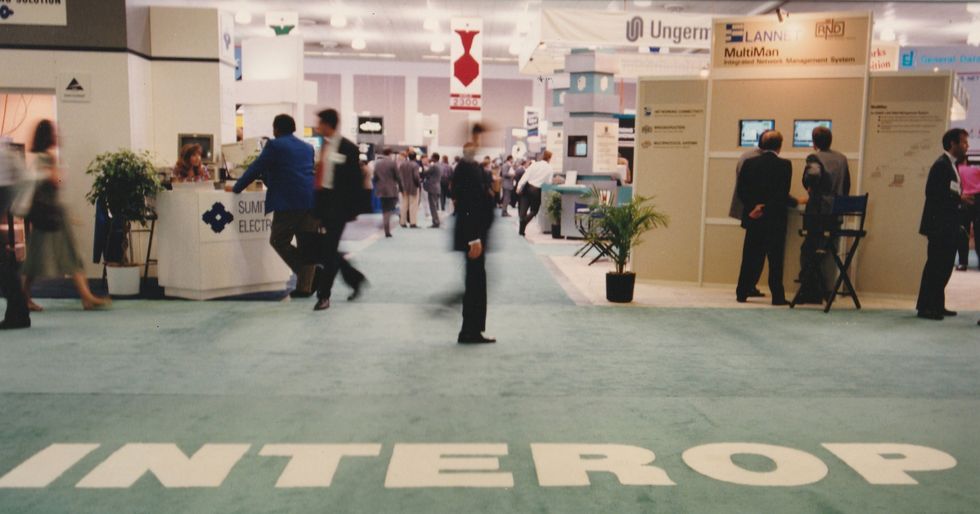 One of the key industry conferences that helped shape the Internet was the 1988 TCP/IP Interoperability Exhibition and Solutions Showcase in Santa Clara, Calif., which was given the shorter, catchier name Interop." Margot Simmons
One of the key industry conferences that helped shape the Internet was the 1988 TCP/IP Interoperability Exhibition and Solutions Showcase in Santa Clara, Calif., which was given the shorter, catchier name Interop." Margot Simmons
Interop featured lots of products: every medium, every bridge box, every router you can imagine," according to Peter de Vries of the Wollongong Group, which was responsible for putting together the network at Interop. That network provided connections among all vendors on display, including equipment available for purchase from Cisco Systems, Proteon, and Wellfleet Communications.
Using TCP/IP, attendees could traverse links to NSFNET, the regional BARRNET in San Francisco, and a variety of other networks. Vendors could participate in TCP/IP bake-offs," where they could check to see whether their equipment interoperated with other vendors' products. Self-appointed net police" went so far as to hand out tickets" to implementations that did not comply with the TCP/IP specifications.
Editor's Note:Much more information about the history of computer networking can be found in the authors' recently published book
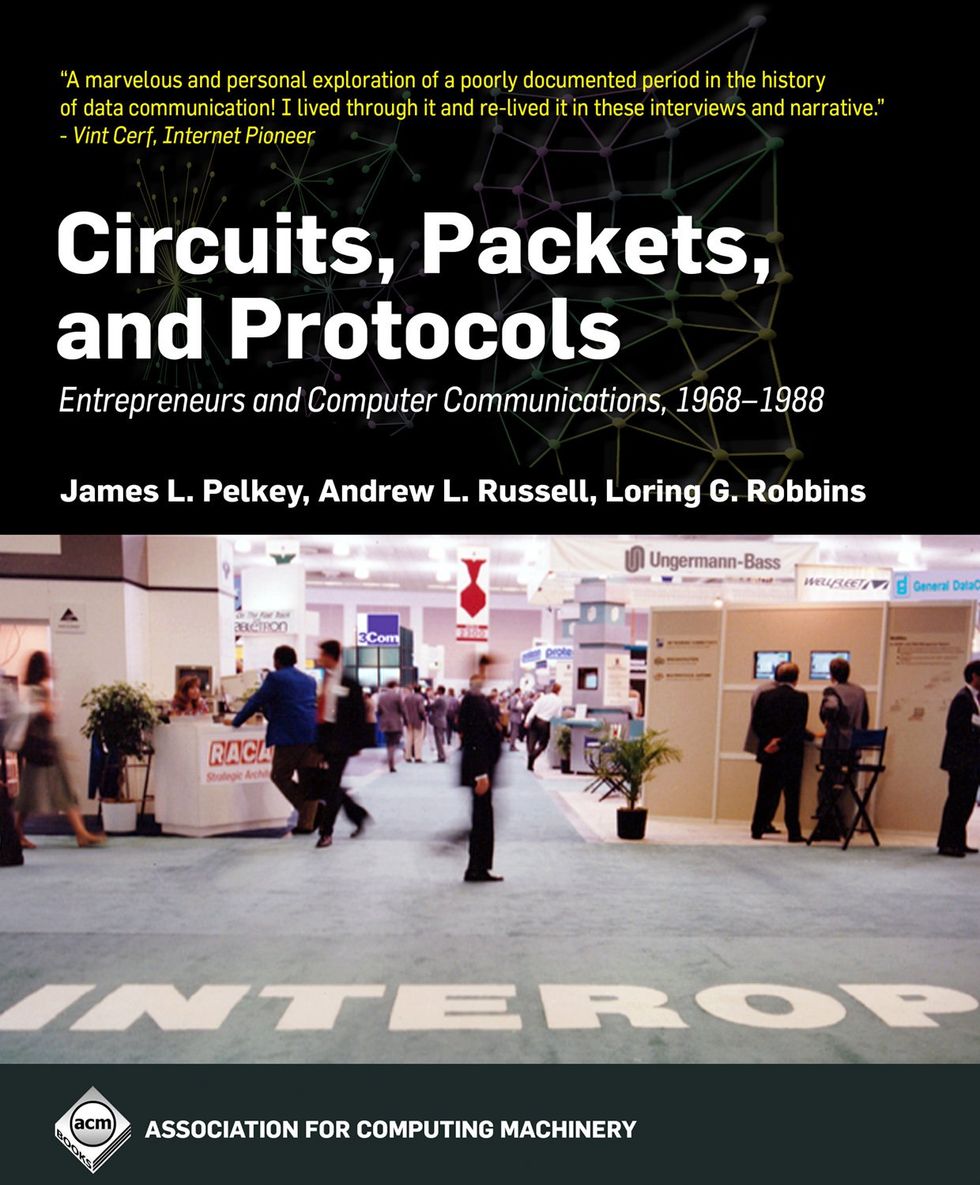
Readers interested in purchasing Circuits, Packets, and Protocols: Entrepreneurs and Computer Communications, 1968-1988 (ACM Books, 2022) will enjoy a 25% discount with the publisher by using the promo code SPECTRUM25"
BUY HERE.
In many respects, Interop '88 was far more successful than ENE. It featured working products from more vendors than did ENE. And whereas ENE carried the burden of people's expectations that it would provide comprehensive solutions for large-scale manufacturing, office, and government procurement, Interop took on the immediate and narrower problems of network interconnection. In the age of standards," as an article in Data Communications referred to that time, this focus on product compatibility, interoperability, and connectivity energized the estimated 5,000 attendees as well as the market for TCP/IP products.
The stage was now set for innovations that would change global society: the invention of the World Wide Web the following year and the privatization of the NSFNET/Internet backbone in the mid-1990s. The advances in global computer networking that have come since then all rest on that initial foundation.
Accounts of the beginnings of modern computing often include dramatic descriptions of a conference that has since become known as the Mother of all Demos"-a 1968 joint meeting of the Association for Computing Machinery and the IEEE Computer Society where ARPA-funded researcher Douglas Engelbart gave a 90-minute presentation that included the use of windows, hypertext, videoconferencing, and the computer mouse, among other innovations. His demo is rightly recognized as a turning point for expanding the realm of the possible in personal computing. But mind-expanding possibilities were also on display-and sometimes even for sale-at the five meetings we've described here. In our view, the contribution of these industry events to the development of today's world of computing shouldn't be forgotten, because the connection of different kinds of computers is the advance that has transformed our lives.
Loring Robbins and Andrew Russell dedicate this article to their coauthor and longtime friend James Pelkey, who died shortly before it was published.